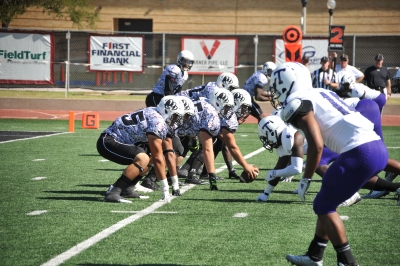By Adam Kirby
Offensive Line Coach
McMurry University (TX)
Twitter: @CoachKirby25
 Over the past few years, McMurry University has lived on its Inside Zone concept averaging 5.48 yards per carry and consistently moving the chains. A big part of that success comes from how we teach that concept. In this clinic report, I will break down our installation process, how we identify fronts, and how our count system allows us to seamlessly block various fronts. In addition, this report will outline what and how I teach zone to my offensive line and our RB reads and entry points.
Over the past few years, McMurry University has lived on its Inside Zone concept averaging 5.48 yards per carry and consistently moving the chains. A big part of that success comes from how we teach that concept. In this clinic report, I will break down our installation process, how we identify fronts, and how our count system allows us to seamlessly block various fronts. In addition, this report will outline what and how I teach zone to my offensive line and our RB reads and entry points.
Here at McMurry University, we are a pro style, multiple formation offense. Within that scheme, our base play that we install on the first two days of camp is Inside Zone. Everything we do in the running game starts from an understanding of our IZ concept. Here is why we like to use this as our base.
Advantages of the Inside Zone Concept:
- Stretches a team horizontally as well as vertically.
- Allows your RB to hit on different holes.
- Allows for the OL to “take the path of least resistance,” meaning they can get to the man they’re blocking quicker, which enables us to play faster.
- Enables us to crease fast flowing defenses.
Identifying Fronts & Count System:
When identifying fronts, our offensive line uses a simple “even/odd” call.
- An “odd front” is any front where the guards are uncovered such as a 3-4 or 3-3.
- Conversely, an “even front” is any front where there are four down linemen such as a 4-3, 4-2, 4-4.
Obviously, this is very general, but I have found this approach to be much easier for the offensive line than making “over/under/bear” front calls. We are able to account for the variances between the fronts through the following steps of our system.
Once we get the front identified, we use a simple count system to help the linemen know who to block. I have found that this system enables us to know exactly whom we are blocking on play side and back side regardless of the front. Our basic rules for the count system are as follows:
- The center is responsible for 0.
- The guards are responsible for 1.
- The tackles are responsible for 2.
- The FB/TE is responsible for 3. In the event that there is no FB/TE, the QB then becomes responsible for 3.
The diagrams below show how we utilize the count system against an “odd” and “even” front with the TE.









